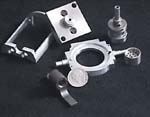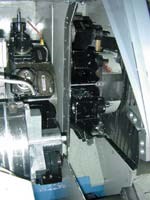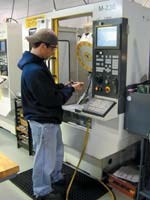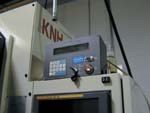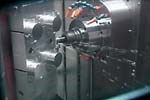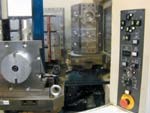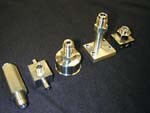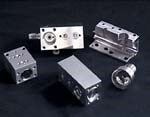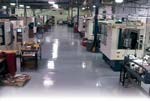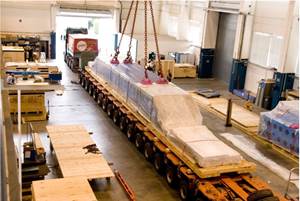The Long View On Short-Run Work
This shop doesn’t know what parts it will machine tomorrow, but it has a good idea who its customers will be well into the future.
APPI, or Atlantic Precision Products Inc., has a formula for success consisting of two ingredients: setups that remain in place and a process continually in motion.
The 75-employee contract shop in Sanford, Maine, has built its business on long-term relationships with OEM customers. These are the kinds of relationships that let APPI invest both capital equipment and process engineering into the job, with the expectation of steady work to come. The process engineering accounts for how the shop secures some of these relationships. The shop devotes considerable time and resources to finding ways to machine parts on a just-in-time basis that some shops might have difficulty machining at all. Tight tolerances and difficult materials are typical of APPI’s jobs. Shop president Bob Martin describes the shop’s forte in two words: “fussy parts.”
A principal component of the shop’s success with these jobs comes from the discipline it exercises in not dismantling setups. Not only the workholding, but also a thorough library of cutting tools remains in place on every horizontal machining center. In fact, this way of using the machines dictated which HMC design the shop chose. Most of the shop’s horizontals were built by Kiwa (imported by CNC Systems of Kennebunk, Maine). The six-pallet version of this company’s HMC concentrates all of its pallets into a small footprint and offers capacity for 120 tools. Using four-sided tombstones with two jobs set up on each face, the shop might have as many as 48 different parts ready to run on one of these machines.
When a setup does change for an active part number at APPI, some change in the method for machining that part is the most likely explanation. Such process changes are common. “Continuous improvement” is an overused term, but the phrase accurately describes the shop’s attitude toward each job. How to win further efficiency gains is a question continually explored. The effort feeds a virtuous circle: By investing to improve the efficiency of each job, APPI holds on to the long-term relationships with customers that let it keep on investing to improve the efficiency of each job.
One process improvement affecting most of the shop’s jobs was the move to horizontal machining centers. Machining center work used to be performed on verticals equipped with pallet switchers, using pallets dense with setups. But once the shop found the right HMCs for its needs—along with the right strategies for these machines—the shop moved quickly. APPI cleared 32 verticals away and replaced them with 16 horizontals.
Not every shop has the luxury of long-term work. Some job shops strive instead to make their processes more effective at responding to work that comes in unexpectedly. But in cases where there is a long-term relationship, APPI’s example offers a model for maximizing a shop’s efficiency with the recurring work.
The Process
APPI learns each day what parts it will machine. The shop has three methods for learning the daily needs of its customers. Kanban is one—a customer’s empty bins tell the shop what to machine so it can deliver refilled bins the next day. For other customers, APPI logs onto the customer’s own MRP system. And in the case of two customers, an automated ordering system sends the shop a daily e-mail listing “must-have” requirements.
Production quantities of three or four pieces at a time are not unusual. The shop looks for jobs that promise an ongoing flow of work, but that flow can be a river or a trickle. “Work that repeats, whether it’s 50 per month or 5,000 per month, is the work we go after,” Mr. Martin says.
The processes for producing these small batches may involve a large amount of engineering. Freedom for designers is one advantage APPI wants to be able to offer customers, so the shop commits to finding efficient ways to machine parts whose material, geometry or tolerance requirements make them difficult to manufacture.
One stainless steel part offers an example. The typical order size for this part is 144, and APPI determined that running the job cost-effectively called for producing this entire batch in an unattended cycle.
But stainless is poorly suited to unattended machining. Inconsistencies in the material produce inconsistent tool life, making it impossible for a programmer to predict how much cutting time a tool should see before the cycle replaces it with a redundant tool. What’s more, the need to run with coolant takes this inconsistent tool life and dramatically shortens it. Coolant over comes stainless steel’s tendency to become gummy because of high cutting temperatures, but the coolant imparts a thermal shock to the tool.
The shop experimented for 2 weeks in search of a process that would reliably deliver the target quantity of 144 parts per cycle. “We tried every coolant, every grade of insert, and various combinations of speed, feed and depth,” Mr. Martin says. “At last I said the heck with it, let’s run dry.”
Cutting without coolant extended tool life, thereby reducing the number of redundant tools needed to a manageable number. A modification the shop itself made to the edges of some tools (the shop wants to keep the details confidential) addressed the potential problems resulting from the steel’s change in consistency at high temperatures.
But that still left the problem of unpredictable life. The shop found the answer to this problem in an electronic accessory—a spindle horsepower monitor offered by another nearby company (Caron Engineering of Wells, Maine). With this monitor installed on the HMC, the NC program for unattended machining changes tools not after a predetermined length of cutting time, but instead when the load on the spindle motor suggests the tool is getting dull.
HMC Advantages
Process engineering like this is an investment in time and attention. When it comes to capital investment, the shop is just as committed. Its most dramatic machine tool investment to date was the move from vertical to horizontal machining centers. After buying its first horizontal, and after experimenting with this machine, there came a period of 18 months during which the shop seemed to be continuously issuing purchase orders for more HMCs, Mr. Martin says. And because of the setups these machines could hold, the shop was continuously sending purchase orders to vise maker Chick throughout that same period.
For APPI, one advantage of horizontal machining centers is their space efficiency. A pallet on a vertical machine offers one surface on which setups can be kept in place. A horizontal machine’s pallet equipped with a tombstone can offer at least four surfaces, and perhaps six or eight. Multiply this number of surfaces by six pallets, and the HMC offers significantly more clamping area relative to the size of its footprint.
Another advantage is the horizontal’s ability to reach multiple faces of the part in one setup by rotating the pallet. A vertical could accomplish something similar using an indexer, but this approach puts the indexing axis on top of the pallet, consuming much of the work space of the machine. A horizontal’s pallet indexer resides under the pallet and outside the work zone.
Mr. Martin says the reduced part handling resulting from the ability to rotate the part in mid-cycle was the most compelling advantage to APPI. The part that persuaded him to commit to horizontals was once machined in eight operations on a vertical, and is now machined in one operation on an HMC.
The design of the HMCs from Kiwa emphasizes the advantages important to APPI. The shop has 8 six-pallet and 7 two-pallet machines from this company. (A 16th machine comes from another builder.) The six-pallet version has a design that stores its 400 mm pallets internally to keep the machine compact. (See photo on facing page.) Both versions of the machine have relatively large tool capacity—120 tools and 64 tools, respectively—allowing the shop to keep a library of tools in place at each machine, including redundant tooling. And on each machine, pallet rotation is accomplished using a full rotary B axis that also permits simultaneous fourth-axis machining.
Keeping setups in place on these machine tools is a form of investment all its own. Space efficient or not, the clamping surface of a pallet or tombstone is a productive resource that could be directed toward some other use when a particular setup isn’t needed.
However, redirecting that resource would impose a cost both coming and going. An operator’s time would have to be spent on removing the setup, and an operator’s time would have to be spent on replacing it again. And if the customer whose part relied on that setup placed an order for the part the next day, then this replacement might have to be performed urgently, taking the operator away from other important work.
Leaving setups alone requires discipline precisely because the costs of failing at this are so subtle. But APPI appreciates what those costs would be. To touch a setup for any reason other than a process improvement or a discontinued part would be to look away from the long view.
Related Content
Lean Approach to Automated Machine Tending Delivers Quicker Paths to Success
Almost any shop can automate at least some of its production, even in low-volume, high-mix applications. The key to getting started is finding the simplest solutions that fit your requirements. It helps to work with an automation partner that understands your needs.
Read MoreHeavy Engineering: The Complex Logistics of Moving Large Machine Tools
One of our fascinations with large-format machine tools has little to do with their capabilities, but everything to do with the logistics involved with getting them up and running. Here’s how one of the world’s oldest builders of giant machine tools tackles the challenge.
Read MoreChoosing a Five-Axis Machine Tool With Automation in Mind
While much focus is placed on the machinery that moves parts, the features most important for automating five-axis machining are arguably found in the machine tool itself.
Read More6 Machine Shop Essentials to Stay Competitive
If you want to streamline production and be competitive in the industry, you will need far more than a standard three-axis CNC mill or two-axis CNC lathe and a few measuring tools.
Read MoreRead Next
The Cut Scene: The Finer Details of Large-Format Machining
Small details and features can have an outsized impact on large parts, such as Barbco’s collapsible utility drill head.
Read MoreObscure CNC Features That Can Help (or Hurt) You
You cannot begin to take advantage of an available feature if you do not know it exists. Conversely, you will not know how to avoid CNC features that may be detrimental to your process.
Read More3 Mistakes That Cause CNC Programs to Fail
Despite enhancements to manufacturing technology, there are still issues today that can cause programs to fail. These failures can cause lost time, scrapped parts, damaged machines and even injured operators.
Read More
.jpg;width=70;height=70;mode=crop)



